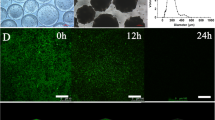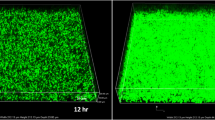Abstract
The foodborne pathogen Listeria monocytogenes has the ability to develop biofilm in food-processing environment, which becomes a major concern for the food safety. The biofilm formation is strongly influenced by the availability of nutrients and environmental conditions, and particularly enhanced in poor minimal essential medium (MEM) containing glucose rather than in rich brain heart infusion (BHI) broth. To gain better insight into the conserved protein expression profile in these biofilms, the proteomes from biofilm- and planktonic-grown cells from MEM with 50 mM glucose or BHI were compared using two-dimensional polyacrylamide gel electrophoresis followed by MALDI-TOF/TOF analysis. 47 proteins were successfully identified to be either up (19 proteins) or down (28 proteins) regulated in the biofilm states. Most (30 proteins) of them were assigned to the metabolism functional category in cluster of orthologous groups of proteins. Among them, up-regulated proteins were mainly associated with the pentose phosphate pathway and glycolysis, whereas a key enzyme CitC involved in tricarboxylic acid cycle was down-regulated in biofilms compared to the planktonic states. These data implicate the importance of carbon catabolite control for L. monocytogenes biofilm formation in response to nutrient availability.


Similar content being viewed by others
References
Behari J, Youngman P (1998) A homolog of CcpA mediates catabolite control in Listeria monocytogenes but not carbon source regulation of virulence genes. J Bacteriol 180:6316–6324
Chandra H, Basir S, Gupta M, Banerjee N (2010) Glutamine synthetase encoded by glnA-1 is necessary for cell wall resistance and pathogenicity of Mycobacterium bovis. Microbiology 156:3669–3677
Chang Y, Gu W, Fischer N, McLandsborough L (2012) Identification of genes involved in Listeria monocytogenes biofilm formation by mariner-based transposon mutagenesis. Appl Microbiol Biotechnol 93(5):2051–2062
Djordjevic D, Wiedmann M, McLandsborough L (2002) Microtiter plate assay for assessment of Listeria monocytogenes biofilm formation. Appl Environ Microbiol 68:2950–2958
Dumas E, Desvaux M, Chambon C, Hébraud M (2009) Insight into the core and variant exoproteomes of Listeria monocytogenes species by comparative subproteomic analysis. Proteomics 9:3136–3155
Fujita Y (2009) Carbon catabolite control of the metabolic network in Bacillus subtilis. Biosci Biotechnol Biochem 73:245–259
Gandhi M, Chikindas M (2007) Listeria: a foodborne pathogen that knows how to survive. Int J Food Microbiol 113:1–15
Helloin E, Jansch L, Phan-Thanh L (2003) Carbon starvation survival of Listeria monocytogenes in planktonic state and in biofilm: a proteomic study. Proteomics 3:2052–2064
Lemon K, Higgins D, Kolter R (2007) Flagellar motility is critical for Listeria monocytogenes biofilm formation. J Bacteriol 189:4418–4424
Mertins S, Joseph B, Goetz M, Ecke R, Seidel G, Sprehe M, Hillen W, Goebel W, Müller-Altrock S (2007) Interference of components of the phosphoenolpyruvate phosphotransferase system with the central virulence gene regulator PrfA of Listeria monocytogenes. J Bacteriol 189:473–490
Nguyen P, Abranches J, Phan T, Marquis R (2002) Repressed respiration of oral streptococci grown in biofilms. Curr Microbiol 44:262–266
O’Toole G, Kaplan H, Kolter R (2000) Biofilm formation as microbial development. Annu Rev Microbiol 54:49–79
Premaratne R, Lin W, Johnson E (1991) Development of an improved chemically defined minimal medium for Listeria monocytogenes. Appl Environ Microbiol 57:3046–3048
Resch A, Leicht S, Saric M, Pásztor L, Jakob A, Götz F, Nordheim A (2006) Comparative proteome analysis of Staphylococcus aureus biofilm and planktonic cells and correlation with transcriptome profiling. Proteomics 6:1867–1877
Riedel C, Monk I, Casey P, Waidmann M, Gahan C, Hill C (2009) AgrD-dependent quorum sensing affects biofilm formation, invasion, virulence and global gene expression profiles in Listeria monocytogenes. Mol Microbiol 71:1177–1189
Sadykov M, Hartmann T, Mattes T, Hiatt M, Jann N, Zhu Y, Ledala N, Landmann R, Herrmann M, Rohde H, Bischoff M, Somerville G (2011) CcpA coordinates central metabolism and biofilm formation in Staphylococcus epidermidis. Microbiology 157:3458–3468
Seidl K, Goerke C, Wolz C, Mack D, Berger-Bächi B, Bischoff M (2008) Staphylococcus aureus CcpA affects biofilm formation. Infect Immun 76:2044–2050
Stoll R, Mertins S, Joseph B, Müller-Altrock S, Goebel W (2008) Modulation of PrfA activity in Listeria monocytogenes upon growth in different culture media. Microbiology 154:3856–3876
Todhanakasem T, Young G (2008) Loss of flagellar-based motility by Listeria monocytogenes results in the formation of hyperbiofilms. J Bacteriol 190:6030–6034
Tsai H, Hodgson D (2003) Development of a synthetic minimal medium for Listeria monocytogenes. Appl Environ Microbiol 69:6943–6945
Ueda A, Attila C, Whiteley M, Wood T (2009) Uracil influences quorum sensing and biofilm formation in Pseudomonas aeruginosa and fluorouracil is an antagonist. Microb Biotechnol 2:62–74
Yamazaki Y, Danelishvili L, Wu M, Macnab M, Bermudez L (2006) Mycobacterium avium genes associated with the ability to form a biofilm. Appl Environ Microbiol 72:819–825
Zhou Q, Feng F, Wang L, Feng X, Yin X, Luo Q (2011) Virulence regulator PrfA is essential for biofilm formation in Listeria monocytogenes but not in Listeria innocua. Curr Microbiol 63:186–192
Zhu Y, Xiong Y, Sadykov M, Fey P, Lei M, Lee C, Bayer A, Somerville G (2009) Tricarboxylic acid cycle-dependent attenuation of Staphylococcus aureus in vivo virulence by selective inhibition of amino acid transport. Infect Immun 77:4256–4264
Acknowledgments
This work was funded by the National Natural Science Foundation of China (30970111), Excellent Youth Foundation of Hubei Scientific Committee (No. 2009CDA124) and CCNU Project (No. CCNU09Y01001).
Author information
Authors and Affiliations
Corresponding author
Additional information
Qingchun Zhou and Xiaoqin Feng contributed equally to this work and should be considered as co-first authors.
Rights and permissions
About this article
Cite this article
Zhou, Q., Feng, X., Zhang, Q. et al. Carbon Catabolite Control is Important for Listeria monocytogenes Biofilm Formation in Response to Nutrient Availability. Curr Microbiol 65, 35–43 (2012). https://doi.org/10.1007/s00284-012-0125-4
Received:
Accepted:
Published:
Issue Date:
DOI: https://doi.org/10.1007/s00284-012-0125-4




